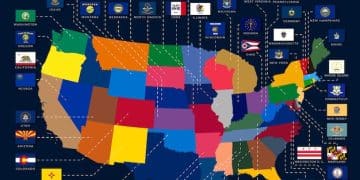Energy Assistance Programs: Reduce Bills with Federal & State Support

Energy assistance programs offer vital support to eligible households in the US, helping to manage and lower utility bills through federal and state-funded initiatives.
Are you struggling with high energy bills? You’re not alone. Fortunately, numerous energy assistance programs are available at the federal and state levels to help eligible households manage their utility costs and maintain essential services.
Understanding Federal Energy Assistance Programs
Federal energy assistance programs provide a crucial safety net for low-income households across the United States. These programs offer financial aid to help families and individuals manage their energy bills, ensuring they can afford to heat and cool their homes.
The primary federal program is the Low Income Home Energy Assistance Program (LIHEAP), which offers various forms of assistance to those who qualify.
What is LIHEAP?
LIHEAP, the Low Income Home Energy Assistance Program, is a federally funded program that helps low-income families with their energy bills. It provides assistance with heating and cooling costs, energy crisis intervention, and weatherization.
Types of Assistance Offered by LIHEAP
LIHEAP offers several types of assistance to eligible households. These include:
- Heating Assistance: Helps with the cost of heating bills during the winter months.
- Cooling Assistance: Provides support for cooling costs during the summer months.
- Crisis Assistance: Offers aid in emergency situations, such as utility shut-offs.
- Weatherization Assistance: Supports energy-efficient home improvements to reduce long-term energy costs.

LIHEAP aims to ensure that low-income households can maintain access to essential energy services, regardless of their financial situation. The program is administered by individual states, which set their own eligibility criteria and benefit levels, so it’s important to check the specific requirements in your state.
Exploring State Energy Assistance Programs
In addition to federal programs like LIHEAP, many states offer their own energy assistance programs. These state-funded initiatives often complement LIHEAP, providing additional support to residents who need help with their energy bills.
State energy assistance programs vary widely in terms of eligibility criteria, types of assistance offered, and funding levels. Here’s what you should know about these programs.
Examples of State-Specific Programs
Several states have unique energy assistance programs that cater to the specific needs of their residents. For example:
- California’s CARE Program: Offers discounted rates on electricity and natural gas bills for income-qualified households.
- New York’s HEAP: Provides financial assistance for heating bills, as well as emergency assistance for households facing a heating crisis.
- Texas’s CEAP: Helps low-income customers pay their electric bills through financial assistance and energy efficiency education.
How to Find State Programs
Finding information about state energy assistance programs involves a few key steps:
- Contacting Your Local Utility Company: Many utility companies have partnerships with state programs and can provide information and referrals.
- Visiting Your State’s Government Website: Most states have a dedicated website for social services or energy assistance, where you can find details about available programs.
- Reaching Out to Community Organizations: Local non-profits and community action agencies often administer state programs and can provide guidance on eligibility and application processes.
State programs can be a valuable resource for those who need additional help managing their energy costs. By exploring the options available in your state, you can find the support you need to stay warm in the winter and cool in the summer without breaking the bank.
Eligibility Requirements for Energy Assistance
To qualify for energy assistance programs, whether federal or state-funded, applicants must meet certain eligibility requirements. These requirements typically focus on household income, size, and energy usage.
Understanding the eligibility criteria is the first step in determining whether you can receive assistance with your energy bills.
Income Guidelines
Income is a primary factor in determining eligibility for most energy assistance programs. Programs like LIHEAP usually have income thresholds based on a percentage of the federal poverty level.
Household Size
Household size is another important consideration. Energy assistance programs often adjust income thresholds based on the number of people living in a household. Larger households typically have higher income limits to reflect their greater energy needs.
Understanding how household size affects eligibility can help you determine whether you qualify for assistance, particularly if you live in a larger family.
Other Factors
Other factors can also play a role in determining eligibility. These include:
- Residency: Applicants usually need to be residents of the state in which they are applying for assistance.
- Citizenship: Many programs require applicants to be U.S. citizens or qualified aliens.
- Energy Usage: Some programs may consider the amount of energy a household uses, especially for crisis assistance.

Meeting the eligibility requirements is crucial for accessing energy assistance programs. By understanding and meeting these criteria, you can increase your chances of receiving the help you need to manage your energy bills.
How to Apply for Energy Assistance Programs
Applying for energy assistance programs involves gathering necessary documents, completing the application, and submitting it to the appropriate agency.
The application process can vary depending on the program and the state, but here are some general steps to follow.
Gathering Necessary Documents
Before you start the application process, gather all the necessary documents. Common documents include:
- Proof of Income: Pay stubs, tax returns, or other documentation showing your household income.
- Identification: Driver’s license, state ID, or other government-issued identification.
- Social Security Numbers: For all household members.
- Utility Bills: Copies of your current energy bills.
Completing the Application
The application form will ask for detailed information about your household, income, and energy usage. Be sure to fill out the form completely and accurately, as incomplete or incorrect information can delay the application process.
Provide all the requested details to ensure your application is processed efficiently.
Submitting the Application
Once you have completed the application, submit it to the appropriate agency. This may be a local social services office, a community action agency, or the state’s energy assistance program office.
Applying for energy assistance programs requires careful preparation and attention to detail. By gathering the necessary documents, completing the application accurately, and submitting it promptly, you can increase your chances of receiving the support you need to manage your energy bills.
Tips for Reducing Your Energy Consumption
In addition to seeking energy assistance programs, there are many steps you can take to reduce your energy consumption and lower your utility bills. These tips can help you save money while also conserving energy.
Reducing your energy usage can have a significant impact on your monthly bills, making your home more affordable and sustainable.
Energy-Efficient Appliances
Using energy-efficient appliances can significantly reduce your energy consumption. Look for appliances with the Energy Star label, which meet strict energy efficiency guidelines set by the U.S. Environmental Protection Agency (EPA).
Choosing Energy Star appliances can save you money on your energy bills while also reducing your carbon footprint.
Simple Energy-Saving Habits
Adopting simple energy-saving habits can also make a big difference.
- Turn off lights when you leave a room.
- Unplug electronics when they are not in use.
- Use a programmable thermostat to adjust the temperature automatically.
- Wash clothes in cold water to save on heating costs.
Making small changes in your daily routine can lead to significant energy savings over time.
Home Improvements
Consider making home improvements to improve energy efficiency, such as:
- Insulating your home to reduce heat loss in the winter and heat gain in the summer.
- Sealing air leaks around windows and doors to prevent drafts.
- Installing energy-efficient windows to reduce energy loss.
Even small home improvements can help you save money on your energy bills and make your home more comfortable year-round.
Advocacy and Resources for Energy Consumers
Navigating the world of energy assistance programs can be complex, but there are numerous advocacy groups and resources available to help energy consumers understand their rights and access the support they need.
These organizations provide valuable information, assistance, and advocacy to ensure that consumers can afford essential energy services.
Consumer Advocacy Groups
Consumer advocacy groups play a critical role in protecting the rights of energy consumers. They advocate for policies that promote affordable energy, provide resources to help consumers manage their energy bills, and offer assistance to those facing energy-related challenges.
Some notable consumer advocacy groups include the National Consumer Law Center and the Consumer Federation of America.
Government Resources
Government resources can also provide valuable information and assistance to energy consumers. The U.S. Department of Energy offers a wealth of information on energy efficiency, renewable energy, and energy assistance programs.
Non-Profit Organizations
Non-profit organizations are also dedicated to helping energy consumers. These organizations often provide direct assistance to low-income households, such as bill payment assistance and energy efficiency upgrades.
Exploring these resources and advocacy groups can empower you to make informed decisions about your energy consumption and access the support you need to manage your energy bills.
| Key Aspect | Brief Description |
|---|---|
| 💡 LIHEAP | Federal program aiding low-income homes with energy costs. |
| 💰 State Programs | Offer additional aid, like California’s CARE or New York’s HEAP. |
| ✅ Eligibility | Based on income, household size, and residency requirements. |
| 🏠 Energy Savings | Use efficient appliances, adopt energy-saving habits, and improve home insulation. |
Frequently Asked Questions (FAQ)
▼
LIHEAP is a federal program that helps low-income families with their energy bills, providing assistance with heating and cooling costs. It also offers crisis intervention and weatherization support to improve energy efficiency.
▼
You can find state programs by contacting your local utility company, visiting your state’s government website, or reaching out to community organizations. These resources can provide details on eligibility and application processes.
▼
Common documents include proof of income (pay stubs, tax returns), identification (driver’s license), Social Security numbers for household members, and copies of your current utility bills for verification purposes.
▼
Simple energy-saving habits include turning off lights when you leave a room, unplugging electronics when not in use, using a programmable thermostat, and washing clothes in cold water to save on heating costs.
▼
You can find more resources through consumer advocacy groups, government agencies like the U.S. Department of Energy, and non-profit organizations that offer direct assistance and information to help you manage your energy bills.
Conclusion
Navigating energy assistance programs can significantly alleviate the financial burden of utility bills for eligible households. By understanding the available federal and state resources, meeting the eligibility requirements, and adopting energy-saving habits, individuals and families can ensure access to essential energy services while managing their expenses effectively.





